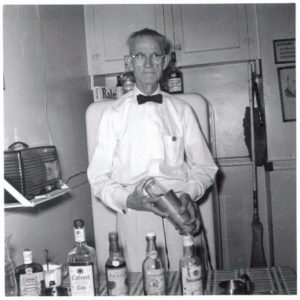“With the repeal of the 18th Amendment the author feels that there has been sufficient demand created for a ‘mixing guide’ that shall be comprehensive in scope, accurate in its recipes, and as modern as it is possible for human ingenuity to make it.” — John L. Caulkins, “The Mixing Master”, 1933 (unpublished manuscript)
*****************

In December 1933 Prohibition was repealed, to the delight of my bartending 2x Great Uncle, John L. Caulkins.
The “Wet Parade of 1933” — as Caulkins called it in a winking nod to the anti-alcohol movie, The Wet Parade, released the year before — had begun in earnest the previous April when Michigan became the first state to ratify the 21st Amendment. Over the next several months 35 other states followed, and by December 5th, the deed was done.
The idea of creating a mixing guide was not new; bartenders compiled and published cocktail recipes and general bar tips long before (and during) Prohibition. The repeal of the 18th amendment merely reinvigorated the market.

Caulkins probably began writing his mixing guide, which he saddled with the slightly unwieldy title of “The Mixing Master: A Real Mixing Guide For Real Mixing People: Repeal Edition” while prohibition was still in effect, revising and/or adding to it when it became clear that the country was headed toward repeal. The “Repeal” Edition notation on the manuscript’s title page, for example, is in sharper type and seems to have been added later.
The manuscript itself is typed on the blank pages of a 6” x 9” three-ring address book. It is 105 pages long and contains approximately 500 recipes, with separate sections for cobblers, cups, fizzes, punches, and sours. There are also instructions for creating various bitters, liqueurs, and syrups – useful information to have in a world before big-box franchise spirits & wines stores provided instant access to such things.
Caulkins’ boasted that his guide
“embraces all the standard drinks, both old and new, as well as many of the modern ‘Hot-Cha’ concoctions, popularized by the present generation, that the ordinary person interested in the mixing art could wish for.”
Those ‘Hot-cha’ concoctions did not, however, include vodka. As cocktail guru extraordinaire David Wondrich points out, vodka was being drunk in the U.S. in the 1930’s, but it was still an outlier for the most part — a “hipster’s secret handshake”, as he puts it.
The Mixing Master does have plenty of Gin-based recipes, as well as many other delights that feature among other things: Absinthe, Brandy, Vermouth, and Whisky. (Caulkins, himself a first generation Irish American, chose to use the Scottish spelling for that distilled spirit, regardless of its country of origin. And, in keeping true to his form, recipes on this blog will call not only for “Scotch Whisky”, but also “Rye Whisky”, “Irish Whisky” etc.)
Whether Caulkins tried and failed to publish his mixing guide, or if he simply set it aside is unknown. The manuscript found its way to me via an old suitcase that belonged to my late grandparents. It is filled with family photos and ephemera dating from 1890 to the late 1950’s. Caulkins lived with my grandparents in the final years of his life; and my grandfather was his nephew.
John L. Caulkins died on October 20, 1962 at the age of 73.


5 comments
Comments are closed.